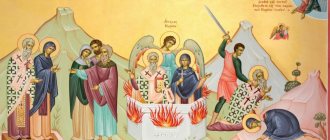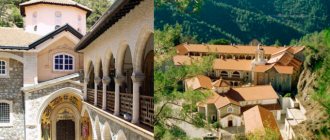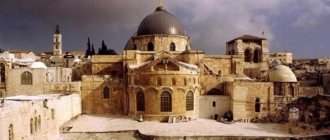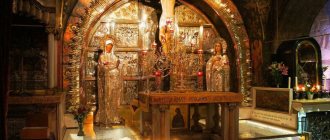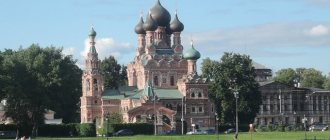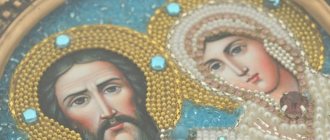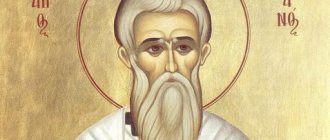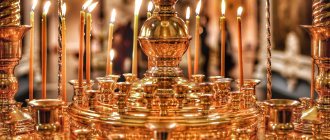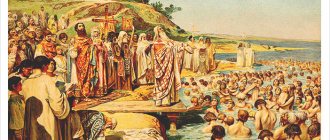Road to the temple
How to get to the church from resort areas and the capital of the island? Coming from Nicosia on the A9 highway, follow the sign for the village of Palaiometocho. The next settlement along the route will be Meniko.
From Larnaca the village can be reached in 40 minutes by Intercity bus. Stop "Latsia". The journey by rented car will take less than half an hour.
From Limassol, take the B9 motorway to the intersection with the A9, where you turn right at the sign for Palaiometocho and continue to Meniko. From Paphos there is a road to Limassol (68 kilometers), and then a repeat of the previous route.
How to get there
It so happened that we approached Meniko from Nicosia, although it is also possible from Troodos. Just plan your route in advance. If you drive along the A1 highway, which branches inland from the A5 highway (between Limassol and Larnaca) towards Nicosia, then just before Nicosia itself there will be an exit to the left towards Troodos - that’s where you need to direct your car’s stops. For about six kilometers in an arc we will move along the edge of Nicosia to the roundabout, where we need to turn left again and again follow the sign for Troodos. Then the “girl” told us how long we needed to go, but earlier on the road we came across a sign for Meniko, where we turned off, and we advise you to do so. From the previous ring to the turnoff point for Meniko, it’s a little less than six kilometers. Still, following the signs in Cyprus is quite normal!
The road goes to the left of the A9 highway and directs us a little deeper into the island towards the south. From the highway exit to the village of Meniko it is about ten kilometers. Halfway through this section we will come across the village of Paliometoxo, which will also serve as a landmark. Five kilometers after it we will enter Meniko. There is no need to accelerate here - if we continue driving straight, then having described a half-circle, we will again find ourselves on the Nicosia - Troodos highway (this is how we returned from Meniko). Our task is not to miss the left turn, which will be not far from the entrance to the village. After the turn, the road will lead deeper into the village and in less than a kilometer will lead to the goal - to the Church of St. Cyprian. Let's look at this place on the map.
History of the temple
The chapel is 7 centuries old. At this place there was a small church, according to legend, built over a cave where an icon of the Mother of God was discovered in the 4th century. In the 12th century, the remains of Saints Cyprian and Ustinha were brought from Rome to Cyprus, to Meniko for salvation from the barbarians.
Appearance of the temple
The power of the sacred relics, healing from damage and the evil eye, became known throughout the island. The Frankish ruler of Cyprus, Petros I, after recovering from a fever, ordered a new church to be built in honor of the great martyrs, and a silver coffin to be made for the relics. In the 18th century, a bell tower was added to the chapel.
Life of Saints Cyprian and Ustinha
The saints lived in the 3rd century, in Syria. Ustinya, a young, beautiful girl, believed in Jesus Christ and became a preacher. Cyprian was known as a great sorcerer and black magician. At the request of the young man in love, he used his knowledge to charm Ustinha, but was powerless.
Having learned that there was a more powerful force, Cyprian believed in Jesus, was baptized, and became a bishop. Ustinya served the Son of God as the abbess of a convent. For preaching Christianity, by order of the Roman emperor, they were tortured and executed.
THE LIFE OF SAINTS CYPRIAN AND JUSTINA
There lived a philosopher and famous sorcerer named Cyprian in Antioch.
Even as a child, he was dedicated to the service of pagan gods and given to sorcerers to teach sorcery and demonic wisdom. Having mastered the devil's tricks and various demonic transformations, he could now send diseases and ulcers to people; from the goddess Hera, he learned many seductions, knew how to call the dead from their graves and make them speak. The Chaldeans taught him to read the stars. And he became a sorcerer, sorcerer and murderer, a great friend and faithful slave of the hellish prince of darkness. He seduced many people to all sorts of iniquities, destroyed many with poison and sorcery, and sacrificed young men and maidens to demons. He taught many his disastrous sorcery: some to fly through the air, others to swim in boats on the clouds, and others to walk on water. Many turned to him in their needs, and he helped them with the demonic power with which he was filled: he helped some in fornication, others in anger, enmity, revenge, envy.
| Icon of Saint Cyprian |
At that time there lived in Antioch a girl named Justina.
One day, having heard the words of salvation from a deacon named Prailia, Justina wanted to learn faith better and more completely: she went to the Church of Christ and, often listening to the word of God, with the influence of the Holy Spirit on her heart, she believed in Christ. The rich young man Aglaid saw Justina and was amazed at her beauty. The devil instilled bad intentions in his heart, and Aglaid began to try by all means to gain the favor and love of Justina and lead the pure lamb of Christ to the defilement he had planned. She answered him: “My groom is Christ; I serve Him and for His sake I maintain my purity. He protects both my soul and body from all defilement.”
Then Aglaid went to the great Cyprian and asked him for help. The sorcerer Cyprian promised to fulfill his wish. Three times Cyprian sent demons to Justina, who caused a storm of bodily lust in Justina’s body, but, turning to the weapon of the sign of the cross and warm prayer to God, the holy virgin put the enemy to shame. Defeated by her prayer, they fled from her in shame.
After this, Cyprian began to take revenge for his shame and brought various disasters to the house of Justina and all her relatives, neighbors and acquaintances. Justina calmed everyone down, saying that soon all disasters would end. And it’s true: when she prayed fervently to God, immediately all the demonic obsession stopped. Convinced that nothing could defeat the power of the sign of the cross and the Name of Christ, Cyprian said to the devil: “Now I have recognized your weakness. For if you fear the cross and tremble at the Name of Christ, then what will you do when Christ Himself comes upon you?”
And Cyprian, having confessed to the bishop, gave him his books to be burned. Seeing his humility, the bishop taught him and instructed him in the holy faith, and then baptized him in the name of the Father and the Son and the Holy Spirit. On the eighth day the bishop made Cyprian a reader, on the twentieth a subdeacon, on the thirtieth a deacon, and a year later he ordained him a priest. Cyprian changed his life, and, constantly mourning his previous evil deeds, improved and ascended from virtue to virtue. He was soon made a bishop and in this rank he led such a holy life that he became equal to many great saints.
Seeing the strict life of Saint Cyprian, the devil prompted the pagans to slander him before the ruler of the eastern country. Many wicked people accused Cyprian and Justina of being hostile to both the gods and the king, that they were confusing the people, seducing them and leading them to Christ. At the same time, they asked that Cyprian and Justina be put to death.
Cyprian and Justina were arrested. Throughout their long torment, they unceasingly confessed Christ and endured everything with thanksgiving. Ruler Claudius condemned them to be beheaded by the sword. So they gave their souls into the hands of God; their bodies lay unburied for six days. Some of the travelers who were there secretly took them to Rome, where they were buried.
| Father Savvas. |
CHURCH OF CYPRIAN IN MENICO.
In the 13th century. The Cypriot chronicler Leontios Macheras spoke in his notes about how, before the fall of Antioch, the relics of Saints Cyprian and Justina, holy martyrs who protected black magicians, evil sorcerers and eye-catching people from harm, were transported to Cyprus. The relics were placed in a small church in the village of Meniko (the road from Nicosia to Troodos). Since that time, many mental and physical healings have occurred among people who came to venerate the holy relics.
In the XIV century. The Cypriot king Petros I, miraculously healed after being applied to the relics of the saints, ordered to build a new large temple on the site of the old church, and place the relics of the saints in a silver ark. Since then, the flow of sufferers to the temple has not dried up.
In the church courtyard, every parishioner can wash himself with holy water from a specially located source outside the church. You will find it in the shade of a huge pine tree under the sign “Agiasma”.
From 8:00 to 13:00, and then from 16:00 to 18:00, one of the priests is usually in the church - Father Savvas or Father Cyprian. Having visited the Church of St. Cyprian during these hours, you can venerate the relics of Saints Cyprian and Justina, submit notes “For health” and “For repose” and venerate the life-giving icon of St. Cyprian, which, according to the traditions of the Cypriot church, is covered with a silver frame. This temple miraculous icon was painted in 1613 by the icon painter artist David. The icon of the Antiochian great martyrs Cyprian and Justina is located to the right of the iconostasis.
At your request, the priest will read a prayer to stop all spells, protecting from the evil eye, evil word and envy, after which you will be able to venerate the relics of Saints Cyprian and Justina.
Relics
The carved gilded iconostasis contains ancient images of Christ the Merciful, the Mother of God, and St. Michael (XVIII century). In the center is the miraculous icon of Cyprian, dating from the 17th century. The icons are located to the right of the iconostasis.
Priests
Prayers and services are performed by two priests: Kyprianou and Savvas.
Relics of saints
The holy remains rest in a silver shrine, which can be accessed from 16.00 to 18.00 daily.
Icon of Saints Cyprian and Ustinha
Icon painters depicted the saint as a middle-aged man, with a beard, wearing the clothes of a saint. With his right hand he blesses the believers, and in his left he holds a closed Gospel wrapped in cloth.
The figure of a young girl is hidden from head to toe by a veil. In her right hand she holds a cross, her open left palm is a symbol of sincere faith.
From sorcery to knowledge of the Divine
On October 15, the Russian Orthodox Church (October 2 - Cyprus) celebrates the day of remembrance of the holy martyrs Cyprian and Justinia. Their story is unique and interesting in that before his baptism, Cyprian (3rd century AD) was a famous black magician and sorcerer, and the martyr Ustinya, thanks to her true faith in Christ, resisted his demonic spells: the girl crushed all the machinations of the devil with prayer and fasting . Every year on October 15, priest Cyprian comes to the church from Moscow and conducts a service in Russian from 8 a.m. to 10:00 a.m.
| Church of St. Cyprian in Meniko |
Where is the Temple of Cyprian and Ustinha?
To touch the relics and images of the great martyrs, pilgrims from all over the world come to the village of Meniko. It is located 20 km from the capital of the island state of Nicosia. The village is small, but very ancient. Her age coincides with the creation of the church.
You can get to the village by rented car in 40 minutes or take one of the excursions offered by travel companies. When traveling alone:
- From Nicosia take the A9 highway. Then turn to Palaiometocho.
- From Larnaca you can take a bus to the Latsia stop.
- From Limassol, first head along the B9 highway until it intersects with the A9. Then turn, following the sign for Palaiometocho.
- From Paphos drive 68 km towards Limassol. Then they move along the specified route.
On a note
A small village stands on the Akaki River. It is home to a little more than 1000 people. Local residents are farmers. They grow fruits and vegetables and engage in livestock farming.
Temple architecture
The structure has a rectangular shape. The high walls are made of natural stone. The windows and doors are narrow and high. The two naves are connected in the shape of a cross. The roof has a complex configuration. It is covered with red tiles. The walls and domes are hand painted. Contemporary Cypriot artists worked on them.
Next to the church there are two shops with souvenirs dedicated to the history of the creation of the temple. You can also buy handmade icons there. The sellers in the shops speak Russian. Girls from Russia have been working there for more than eight years. They are happy to communicate with visitors, telling the history of the church and the miracles that happen there.
The Legend of the Christian Martyrs
Cyprian, who lived during the reign of the Roman emperor Decius Trajan, was revered by pagans in Antioch as a sage, sorcerer and magician.
Having learned the wisdom of paganism and sorcery, he became a pagan priest initiated on Olympus, and later the main one, known for his ability to control the natural elements, send disasters and deadly diseases.
One day, Aglaid, the son of a rich and noble family in Antioch, approached Cyprian with a request to attract the attention of the girl Justina, so that she would reciprocate and become his wife. Cyprian agreed to help, however, despite all the efforts of the sorcerer to bewitch the girl, the beautiful and meek Justina refused the young man, declaring that she was faithful to one man - Jesus.
Three times the sorcerer cast demonic spells on Justina, but, realizing that his efforts were in vain, and his teachings were useless in front of the will and chastity of the girl, he renounced the devil’s deeds and did not leave the temple until he cleansed his soul of sins and received baptism.
The fate of Cyprian and Justina, who converted to Christianity, was decided by the pagans, who slandered them, subjected them to painful torture so that they would renounce their faith, and then completely sentenced them to death.
Later, miracles of healing were performed at the graves of Justina and Cyprian, and soon the Orthodox Church recognized them as holy martyrs.
